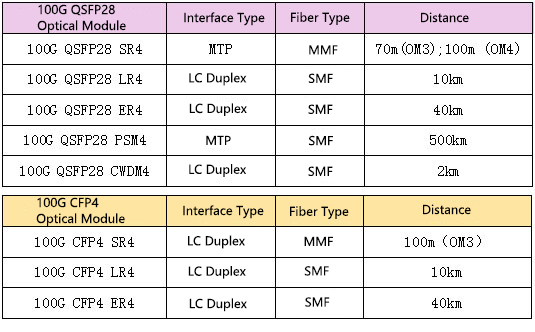

 Knowledge Base +
Knowledge Base +  2024.02.01
2024.02.01As the scale of the 100G industry expands and the speed of optical communication data centers advances, it is an inevitable trend that the cost of 100G optical modules will correspondingly decrease, thereby reducing the overall deployment cost of 100G networks.
The 100G QSFP28 optical module first appeared in 2013. After several years of development, the 100G QSFP28 optical module has spawned multiple categories, each with different optical module standards suitable for different transmission applications.
The 100G CFP optical module, also known as the 100G client-side module, is a form-factor pluggable module that supports hot swapping. The CFP series optical modules have gone through the development from CFP to CFP2, and now, the CFP4 optical module has been successfully launched and widely praised.
In 5G, the 'G' stands for Generation, indicating the fifth generation of communication. 100G refers to the data rate of the optical module. QSFP28 and CFP4 are the package representations of optical modules, representing the form factor, the range of transmission, the fiber transmission channel, and the unified protocol provisions. So, which one, between the 100G QSFP28 optical module and the 100G CFP4 optical module, has better performance and price advantages?
QSFP28 Optical Module VS CFP4 Optical Module
● Port Density
The CFP4 optical module is the latest generation of 100G optical modules in the CFP package form. Compared to the QSFP28 optical module, although its width is only 1/4 of the size of the first-generation CFP, its package size is still larger than the QSFP28 optical module, indicating that the QSFP28 optical module has a better port utilization rate.
● High-Density Wiring
The 100G QSFP28 optical module uses four optical fiber channels to transmit data, and the transmission rate of each optical fiber channel can reach up to 28Gbps, mainly used for 100G transmission applications. Compared with the 100G CFP4 optical module, the 100G QSFP28 optical module is more suitable for high-density wiring, and most data centers tend to choose the 100G QSFP28 optical module.
● Optical Module Classification
The 100G QSFP28 optical module and the 100G CFP4 optical module have spawned multiple categories, and below I will present the categories between the two in tabular form:

Choosing Between 100G CFP and QSFP28
When building a network, the choice between these two types of modules needs to consider two main factors: the type of hardware equipment and the application environment. In terms of size, CFP optical modules are much larger than QSFP28 modules. Regarding transmission distance, QSFP28 is commonly used for short-distance connections between switches (0-10km). However, QSFP28 ER4/ZR4, paired with single-mode fiber, can also be used for long-distance transmissions of up to 40km/80km. While CFP modules can also be used for short-distance transmissions, metropolitan area networks and long-haul WDM transmissions are where 100G CFP truly shines.
Additional Learning Hub Resources
What is the biggest difference between SFP, SFP+, SFP28, QSFP+, QSFP28, QSFP-DD, and OSFP?
What are the types of QSFP transceivers
What is the difference between 40G QSFP+ singlemode and QSFP+ multimode?
Subscribe to the newsletter
for all the latest updates.
2-5# Building, Tongfuyu Industrial Zone, Aiqun Road, Shiyan Street, Baoan District, Shenzhen. China
